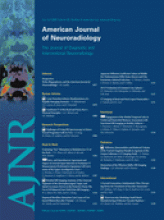Abstract
BACKGROUND AND PURPOSE: Realistic, population based cerebrovascular replicas are required for the development of neuroendovascular devices. The objective of this work was to develop an efficient methodology for manufacturing realistic cerebrovascular replicas.
MATERIALS AND METHODS: Brain MR angiography data from 20 patients were acquired. The centerline of the vasculature was calculated, and geometric parameters were measured to describe quantitatively the internal carotid artery (ICA) siphon. A representative model was created on the basis of the quantitative measurements. Using this virtual model, we designed a mold with core-shell structure and converted it into a physical object by fused-deposit manufacturing. Vascular replicas were created by injection molding of different silicones. Mechanical properties, including the stiffness and luminal coefficient of friction, were measured.
RESULTS: The average diameter, length, and curvature of the ICA siphon were 4.15 ± 0.09 mm, 22.60 ± 0.79 mm, and 0.34 ± 0.02 mm−1 (average ± standard error of the mean), respectively. From these image datasets, we created a median virtual model, which was transformed into a physical replica by an efficient batch-manufacturing process. The coefficient of friction of the luminal surface of the replica was reduced by up to 55% by using liquid silicone rubber coatings. The modulus ranged from 0.67 to 1.15 MPa compared with 0.42 MPa from human postmortem studies, depending on the material used to make the replica.
CONCLUSIONS: Population-representative, smooth, and true-to-scale silicone arterial replicas with uniform wall thickness were successfully built for in vitro neurointerventional device-testing by using a batch-manufacturing process.
- Copyright © American Society of Neuroradiology












